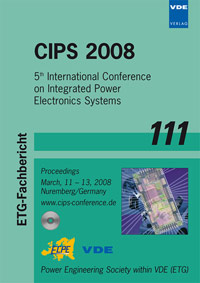Design and assembly of power semiconductors with double-sided water cooling
Conference: CIPS 2008 - 5th International Conference on Integrated Power Electronics Systems
03/11/2008 - 03/13/2008 at Nuremberg, Germany
Proceedings: CIPS 2008
Pages: 7Language: englishTyp: PDF
Personal VDE Members are entitled to a 10% discount on this title
Authors:
Schneider-Ramelow, Martin; Baumann, Thomas; Hoene, Eckart (Fraunhofer IZM Berlin, Deutschland)
Abstract:
The presentation addresses the alternative assembly of power semiconductors (IGBTs and diodes) with direct liquid cooling from the top and bottom side. The technology extends the current carrying capability of semiconductors significantly by reducing the thermal resistance between semiconductors and cooling liquid. Especially in the case of converters employed for propulsion in cars, the innovation will reduce the system cost and increase assembly lifetime. Particular challenges in this type of assembly are thermal-mechanical reliability, the low thermal resistance and the difficulty of designing the required production processes. High-voltage resistance, power supply and the sealing of cooling ducts have to be solved as well. Investigations include today's problems with conventionally soldered and heavy wire bonded power modules as well as some alternative assembly possibilities which are currently under discussion or being tested, respectively. The concept of contacting semiconductors between two substrates (e.g. DCBs) with cooling from both sides will be discussed in detail. The demonstrator shown in this presentation is used to establish the technology's viability and its estimated characteristics, particularly in terms of lifetime. It comprises a half bridge with two IGBTs and diodes, which are soldered onto DCBs on both sides. Through the additional thermal dissipation on the upper surface, static thermal resistance is reduced by 40% compared to one-sided cooling assemblies. Dynamic thermal resistance is also significantly reduced through the thermal mass of the second DCB. The main challenges of contacting semiconductors quality-like between two substrates with top and bottom cooling liquid are the availability of semiconductors for soldering or sintering from both sides with optimized pad layout, adjusted DCB layout as well as encapsulation technologies to achieve appropriate insulation capability, the assembly technology and the sealing of cooling ducts. Reliability topics are the fatigue/creep behavior of the semiconductor to substrate contacts, the mechanical stability of the DCBs and thermo-mechanical mismatch between the applied materials. A prototype is introduced and measurement results concerning thermal resistance, quality of assembly and lifetime are presented.


